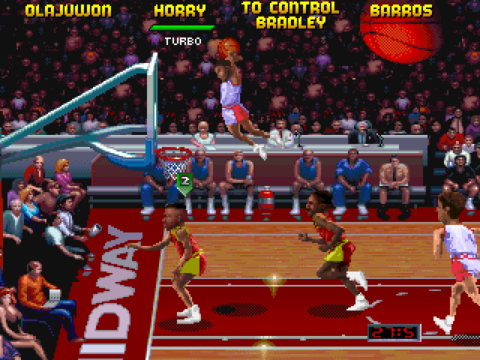
NBA Jam: Tournament Edition
Written by: Rik
Date posted: June 14, 2020
- Genre: Sport
- Developed by: Iguana Entertainment
- Published by: Acclaim
- Year released: 1995
- Our score: 6
The glitzy world of the NBA made a sudden and unexpected appearance in the lives of pasty UK youths in the early 90s, thanks mainly to the impact of the Michael Jordan, the 1992 Dream Team, and the Chicago Bulls. Somehow, all the league’s big stars made their way into the consciousness of British teenagers, many of whom may well have been ignorant of the rules of the game of basketball, but felt perfectly comfortable wearing Air Jordan shoes or a Shaquille O’Neal T-shirt.
However, any notions, if they existed, of emulating MJ, Shaq et al in real life, were in most cases swiftly deflated when confronted with the hard realities of the game: the technique required to master the basics, a ball that was much heavier than it looked, and the realisation that slam dunks were out of the question for puny 5ft 8in weaklings. As ever, video games provided a less challenging access route to the sport, and the most prominent one of the era also happened to feature a greatly simplified version of the game, with fewer players per team, virtually no rules, and – most importantly – an emphasis on ludicrous dunks, with players launched miles into the air as an excitable commentator uttered memorable, but borderline-nonsensical catchphrases: welcome to NBA Jam!
In 1994, the idea of this one-time arcade favourite making its way to PC would have been fanciful, with its action-packed hi-jinks best suited to the 16-bit consoles of the day. However, a year or so later, the slightly-updated Tournament Edition did wing its way to DOS machines (although as far as I recall, it was a fairly low-key, possibly budget-only release, escaping any high profile review coverage), by which point UK-based NBA fever had died down slightly, with Michael Jordan retiring and then un-retiring during this period. In any case, Jordan isn’t actually in any home version of the game (despite the proliferation of schoolyard rumours of a special secret unlock code) due to his personal image rights arrangements, although PC gamers, and fans of the great man himself, could console themselves with exclusive access to, er, Michael Jordan in Flight.
Anyway, as we mentioned, NBA Jam is an extremely loose interpretation of basketball, based on the arcade game, a coin-guzzling two-on-two affair. Taking charge of any of the (then) 27 NBA teams, you must defeat them all to claim the overall title, although despite the sneakily-misleading name, there’s no NBA season or meaningful tournament option on offer here. Turning ‘tournament’ mode on just locks out certain options, including the more wacky additions (such as power-ups and special areas on the court that may net additional points), keeps the difficulty at a certain level, and turns off computer assistance (which artificially keeps the scores close). Another significant new feature is the inclusion of a third player in each squad, and an injury statistic as the game progresses, which adds a tactical element, including substitutions.
Out on the court, simple controls enable accessible play. One button passes, another shoots, and a third adds turbo. With the ball, you can also hammer turbo while stationary to ward off opponents, tap shoot to fake a shot (head fake), and hold shoot then hit pass to begin a jump shot and release the ball to a team mate. Off the ball, pass attempts a swipe at the ball and a possible steal, while shoot launches your player into the air for a block or to grab a possible rebound. Combining turbo with steal has your player pushing an opponent to the ground, with no penalty, as the rules are only very loosely enforced here, with no fouls and only goal-tending [interfering with the ball on a downward flight towards your own basket – Ed.] penalised. You have the option of only having direct control over one of your pair of players, with your team-mate capable of acting independently but also responding to your button presses, or having control switch between the two players with the ball, known here as Tag Mode. I chose the latter, as it’s the way most sports games usually work, but series fans may have their own preferences.
As mentioned, big, exaggerated dunks are all part of the fun, and if one of your two players scores three times in a row without interruption, he’ll be, in the words of commentator Tim Kitzrow, ‘on fire’, and in theory should be able to hurl the ball, now a molten rock of lava, into the basket much more easily, until your opponent scores, or he successfully shoots four more baskets in a row.
Controls on PC are, as ever, hamstrung by the proliferation of two-button joysticks (and hence control schemes) at the time, although these can be circumnavigated in the modern era by using a keymapper (I used AntiMicro, which worked well enough, but there’s one built into DOSBox too). Visually, it’s the usual case of the flashy console graphics of the era retaining the same core properties but also losing something in the translation to bog-standard VGA. There are loads of versions of Jam TE, and without wanting to make claims of performing a detailed comparison, I did briefly check out the Megadrive and PlayStation versions for reference.This DOS version boasts the detailed player heads and sprite scaling that are both absent on the Megadrive, although it doesn’t have the latter’s camera flash effects from the crowd that appear during dunk attempts. You’d have to say, too, that the player heads are pretty blurry here, to the extent that any significant advantage is lost, while the player scaling seems very exaggerated to me, with players looking huge when close and tiny when at the far side of the court. On the audio side, the DOS version also features player names in the commentary, instead of just the signature utterances (‘Boomshakalaka!’, ‘Oh my!’, the aforementioned ‘He’s on fire’ etc), as is the case in the cartridge version. However, the PlayStation version has everything the DOS version has, but is superior in every way on the audio-visual front.
But despite some rough edges, this is still recognisably NBA Jam, and taken on its own merits, there’s a solid game here, roughly in line with my memories of callow multiplayer encounters on the aforementioned Megadrive, although my tactics from those days of lazily alternating between trying for unlikely 3-pointers and the most spectacular dunk possible were soon discarded as insufficient for success against the standard level AI opponents here. While the tactical element of basketball is significantly reduced, clearly some strategy is required, both on-court, and off, including the need to pay attention to your own player’s stats (with regard to 3-point or dunking skills, for example) and those of the opposition, and manage your three players and their injury levels throughout the game.
In terms of criticisms, it does seem to be even more fast and chaotic than other versions, with the camera often failing to keep up with the action, passes often going badly awry, the amount of available turbo seeming rather generous, and successful shoves to the floor achieved with some regularity. I also wasn’t entirely sure the stats always correlated with performance: playing as the Houston Rockets, Hakeem Olajuwon had a 2/10 rating for 3-pointers, but seemed to have as much luck as the others in this respect, while his superior dunking and strength didn’t seem to be as evident. Still, all the players do seem to have different skills and personalities, and it’s fun to try out different teams and get used to their strengths and weaknesses.
While it’s probably not the best available version of NBA Jam: TE, and you could even avail yourself of the arcade original should you so desire, this port certainly delivers an enjoyable slice of basketball, er, cake. If my performances in the other version are anything to go by, the overall difficulty levels have been slightly relaxed here, too, which may well be down to the restrictions on controls, or a general feeling that PC gamers needed all the help they could get with this kind of title (or it could all be in my mind, who knows). It’s never really been a game of longevity, with the arcade structure (greeting you with a ‘Game Over’ after every match, win or lose) grating slightly against the sporting obsession with stats and tables, but to beat all 27 teams will certainly keep you entertained for some time.

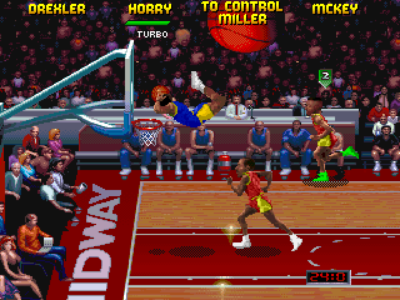
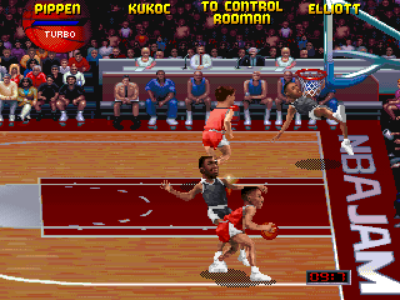
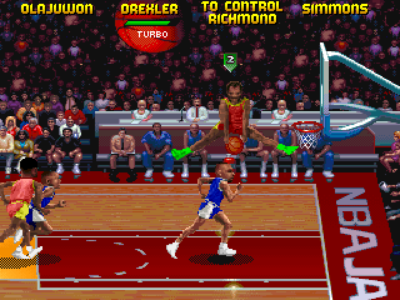
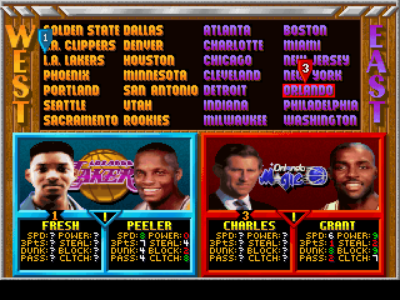

 Posts
Posts
When I saw the title ‘Michael Jordan in Flight’, my mind went to His Airness as an alcoholic pilot that raids hotel mini bars and steals and consumes all their mickeys!
(Cuz Denzel did it in that movie ‘Flight’, didnt he?)
June 12, 2023 @ 9:15 pm